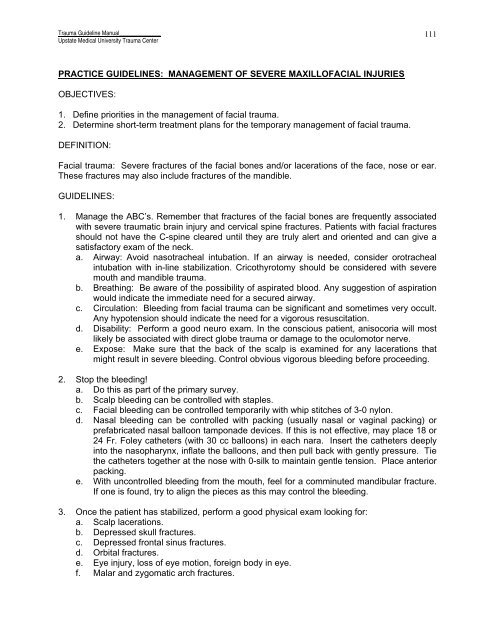Trauma Guideline Manual - SUNY Upstate Medical University
Trauma Guideline Manual - SUNY Upstate Medical University
Trauma Guideline Manual - SUNY Upstate Medical University
You also want an ePaper? Increase the reach of your titles
YUMPU automatically turns print PDFs into web optimized ePapers that Google loves.
<strong>Trauma</strong> <strong>Guideline</strong> <strong>Manual</strong>______________<strong>Upstate</strong> <strong>Medical</strong> <strong>University</strong> <strong>Trauma</strong> Center111PRACTICE GUIDELINES: MANAGEMENT OF SEVERE MAXILLOFACIAL INJURIESOBJECTIVES:1. Define priorities in the management of facial trauma.2. Determine short-term treatment plans for the temporary management of facial trauma.DEFINITION:Facial trauma: Severe fractures of the facial bones and/or lacerations of the face, nose or ear.These fractures may also include fractures of the mandible.GUIDELINES:1. Manage the ABC’s. Remember that fractures of the facial bones are frequently associatedwith severe traumatic brain injury and cervical spine fractures. Patients with facial fracturesshould not have the C-spine cleared until they are truly alert and oriented and can give asatisfactory exam of the neck.a. Airway: Avoid nasotracheal intubation. If an airway is needed, consider orotrachealintubation with in-line stabilization. Cricothyrotomy should be considered with severemouth and mandible trauma.b. Breathing: Be aware of the possibility of aspirated blood. Any suggestion of aspirationwould indicate the immediate need for a secured airway.c. Circulation: Bleeding from facial trauma can be significant and sometimes very occult.Any hypotension should indicate the need for a vigorous resuscitation.d. Disability: Perform a good neuro exam. In the conscious patient, anisocoria will mostlikely be associated with direct globe trauma or damage to the oculomotor nerve.e. Expose: Make sure that the back of the scalp is examined for any lacerations thatmight result in severe bleeding. Control obvious vigorous bleeding before proceeding.2. Stop the bleeding!a. Do this as part of the primary survey.b. Scalp bleeding can be controlled with staples.c. Facial bleeding can be controlled temporarily with whip stitches of 3-0 nylon.d. Nasal bleeding can be controlled with packing (usually nasal or vaginal packing) orprefabricated nasal balloon tamponade devices. If this is not effective, may place 18 or24 Fr. Foley catheters (with 30 cc balloons) in each nara. Insert the catheters deeplyinto the nasopharynx, inflate the balloons, and then pull back with gently pressure. Tiethe catheters together at the nose with 0-silk to maintain gentle tension. Place anteriorpacking.e. With uncontrolled bleeding from the mouth, feel for a comminuted mandibular fracture.If one is found, try to align the pieces as this may control the bleeding.3. Once the patient has stabilized, perform a good physical exam looking for:a. Scalp lacerations.b. Depressed skull fractures.c. Depressed frontal sinus fractures.d. Orbital fractures.e. Eye injury, loss of eye motion, foreign body in eye.f. Malar and zygomatic arch fractures.
















